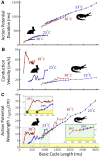Defibrillate You Later, Alligator: Q10 Scaling and Refractoriness Keeps Alligators from Fibrillation
- PMID: 33977229
- PMCID: PMC8101277
- DOI: 10.1093/iob/obaa047
Defibrillate You Later, Alligator: Q10 Scaling and Refractoriness Keeps Alligators from Fibrillation
Abstract
Effective cardiac contraction during each heartbeat relies on the coordination of an electrical wave of excitation propagating across the heart. Dynamically induced heterogeneous wave propagation may fracture and initiate reentry-based cardiac arrhythmias, during which fast-rotating electrical waves lead to repeated self-excitation that compromises cardiac function and potentially results in sudden cardiac death. Species which function effectively over a large range of heart temperatures must balance the many interacting, temperature-sensitive biochemical processes to maintain normal wave propagation at all temperatures. To investigate how these species avoid dangerous states across temperatures, we optically mapped the electrical activity across the surfaces of alligator (Alligator mississippiensis) hearts at 23°C and 38°C over a range of physiological heart rates and compare them with that of rabbits (Oryctolagus cuniculus). We find that unlike rabbits, alligators show minimal changes in wave parameters (action potential duration and conduction velocity) which complement each other to retain similar electrophysiological wavelengths across temperatures and pacing frequencies. The cardiac electrophysiology of rabbits accommodates the high heart rates necessary to sustain an active and endothermic metabolism at the cost of increased risk of cardiac arrhythmia and critical vulnerability to temperature changes, whereas that of alligators allows for effective function over a range of heart temperatures without risk of cardiac electrical arrhythmias such as fibrillation, but is restricted to low heart rates. Synopsis La contracción cardíaca efectiva durante cada latido del corazón depende de la coordinación de una onda eléctrica de excitación que se propaga a través del corazón. Heterogéidades inducidas dinámicamente por ondas de propagación pueden resultar en fracturas de las ondas e iniciar arritmias cardíacas basadas en ondas de reingreso, durante las cuales ondas espirales eléctricas de rotación rápida producen una autoexcitación repetida que afecta la función cardíaca y pude resultar en muerte súbita cardíaca. Las especies que funcionan eficazmente en una amplia gama de temperaturas cardíacas deben equilibrar los varios procesos bioquímicos que interactúan, sensibles a la temperatura para mantener la propagación normal de ondas a todas las temperaturas. Para investigar cómo estas especies evitan los estados peligrosos a través de las temperaturas, mapeamos ópticamente la actividad eléctrica a través de las superficies de los corazones de caimanes (Alligator mississippiensis) a 23°C and 38°C sobre un rango de frecuencias fisiológicas del corazón y comparamos con el de los conejos (Oryctolagus cuniculus). Encontramos que a diferencia de los conejos, los caimanes muestran cambios mínimos en los parámetros de onda (duración potencial de acción y velocidad de conducción) que se complementan entre sí para retener longitudes de onda electrofisiológicas similares a través de los rangos de temperaturas y frecuencias de ritmo. La electrofisiología cardíaca de los conejos acomoda las altas frecuencias cardíacas necesarias para mantener un metabolismo activo y endotérmico a costa de un mayor riesgo de arritmia cardíaca y vulnerabilidad crítica a los cambios de temperatura, mientras que la de los caimanes permite un funcionamiento eficaz en una serie de temperaturas cardíacas sin riesgo de arritmias eléctricas cardíacas como la fibrilación, pero está restringida a bajas frecuencias cardíacas.
© The Author(s) 2021. Published by Oxford University Press on behalf of the Society for Integrative and Comparative Biology.
Figures




Similar articles
-
Beyond Janzen's Hypothesis: How Amphibians That Climb Tropical Mountains Respond to Climate Variation.Integr Org Biol. 2023 May 3;5(1):obad009. doi: 10.1093/iob/obad009. eCollection 2023. Integr Org Biol. 2023. PMID: 37151602 Free PMC article.
-
Measurement and evaluation of national family planning programs.Demography. 1967 Mar;4(1):71-80. doi: 10.2307/2060351. Demography. 1967. PMID: 21279762
-
Longitudinal hemodynamics in acute phase of treatment with labetalol in hypertensive pregnant women to predict need for vasodilatory therapy.Ultrasound Obstet Gynecol. 2017 Jan;49(1):85-94. doi: 10.1002/uog.17335. Epub 2016 Dec 1. Ultrasound Obstet Gynecol. 2017. PMID: 27762457
-
[Cardiorenal syndrome: Clinical and echocardiographic aspects].Arch Cardiol Mex. 2020;90(4):503-510. doi: 10.24875/ACM.20000087. Arch Cardiol Mex. 2020. PMID: 33373357 Review. Spanish.
-
Arrhythmic mitral valve complex: diagnostic and therapeutic approach.Arch Cardiol Mex. 2025;95(2):225-234. doi: 10.24875/ACM.24000097. Arch Cardiol Mex. 2025. PMID: 40445931 Free PMC article. Review. English.
Cited by
-
Thermal effects on cardiac alternans onset and development: A spatiotemporal correlation analysis.Phys Rev E. 2021 Apr;103(4):L040201. doi: 10.1103/PhysRevE.103.L040201. Phys Rev E. 2021. PMID: 34005953 Free PMC article.
-
Optical mapping of contracting hearts.J Physiol. 2023 Apr;601(8):1353-1370. doi: 10.1113/JP283683. Epub 2023 Mar 19. J Physiol. 2023. PMID: 36866700 Free PMC article. Review.
-
Methodological analysis of dual voltage-calcium whole-heart optical signals during restitution pacing under different thermal states.Conf Eur Study Group Cardiovasc Oscil. 2022 Oct;2022:10.1109/esgco55423.2022.9931366. doi: 10.1109/esgco55423.2022.9931366. Epub 2022 Nov 7. Conf Eur Study Group Cardiovasc Oscil. 2022. PMID: 40070816 Free PMC article.
References
-
- Allessie MA, Bonke FI, Schopman FJ.. 1976. Circus movement in rabbit atrial muscle as a mechanism of tachycardia. II. The role of nonuniform recovery of excitability in the occurrence of unidirectional block, as studied with multiple microelectrodes. Circ Res 39:168–77. - PubMed
-
- Allessie MA, Bonke FI, Schopman FJ.. 1977. Circus movement in rabbit atrial muscle as a mechanism of tachycardia. III. The “leading circle” concept: a new model of circus movement in cardiac tissue without the involvement of an anatomical obstacle. Circ Res 41:9–18. - PubMed
-
- Beddard FE, Mitchell PC.. 1895. On the structure of the heart of the alligator. Proceedings of the Zoological Society, London. p. 343–9.
-
- Bennett AF. 1982. The energetics of reptilian activity, In: Gans C, Pough PH, editors. Biology of the reptilia. Vol. 13. New York (NY): Academic Press, p. 155–99.
-
- Bennett AF. 1985. Temperature and muscle. J Exp Biol 115:333–44. - PubMed
Grants and funding
LinkOut - more resources
Full Text Sources
Other Literature Sources
Research Materials
